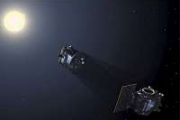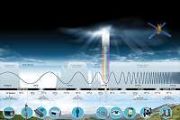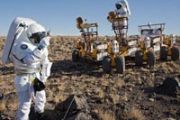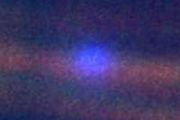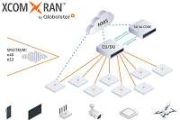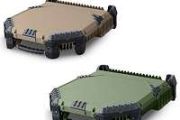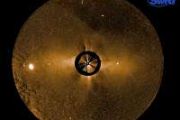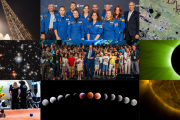
Copernical Team
Earthly rocks point way to water hidden on Mars
 A combination of a once-debunked 19th-century identification of a water-carrying iron mineral and the fact that these rocks are extremely common on Earth, suggests the existence of a substantial water reservoir on Mars, according to a team of geoscientists.
"One of my student's experiments was to crystalize hematite," said Peter J. Heaney, professor of geosciences, Penn State. "She came up
A combination of a once-debunked 19th-century identification of a water-carrying iron mineral and the fact that these rocks are extremely common on Earth, suggests the existence of a substantial water reservoir on Mars, according to a team of geoscientists.
"One of my student's experiments was to crystalize hematite," said Peter J. Heaney, professor of geosciences, Penn State. "She came up Clays, not water, are likely source of Martian lakes
 Where there's water, there's life. That's the case on Earth, at least, and also why scientists remain tantalized by any evidence suggesting there's liquid water on cold, dry Mars. The Red Planet is a difficult place to look for liquid water: While water ice is plentiful, any water warm enough to be liquid on the surface would last for only a few moments before turning into vapor in Mars' wispy a
Where there's water, there's life. That's the case on Earth, at least, and also why scientists remain tantalized by any evidence suggesting there's liquid water on cold, dry Mars. The Red Planet is a difficult place to look for liquid water: While water ice is plentiful, any water warm enough to be liquid on the surface would last for only a few moments before turning into vapor in Mars' wispy a Redwire to demonstrate In-Space Additive Manufacturing on ISS for Lunar operations
 Redwire reports that it is launching new manufacturing hardware to the International Space Station (ISS) that will demonstrate additive manufacturing processes using lunar regolith simulant. This demonstration is critical to advancing the ability to develop a permanent presence for humankind on the Moon using in-situ resources.
This will be the first time that lunar regolith simulant has b
Redwire reports that it is launching new manufacturing hardware to the International Space Station (ISS) that will demonstrate additive manufacturing processes using lunar regolith simulant. This demonstration is critical to advancing the ability to develop a permanent presence for humankind on the Moon using in-situ resources.
This will be the first time that lunar regolith simulant has b Space company in search for professionals
 Despite the exceptional economic situation caused by the pandemic, space industry is showing an upward trend. New ways of working, new ways of collaboration and new, hybrid events promote digital technologies for worldwide communication and data transmission and thus also increase the demand for future-oriented solutions.
Such as made possible by the space company TESAT in Backnang near St
Despite the exceptional economic situation caused by the pandemic, space industry is showing an upward trend. New ways of working, new ways of collaboration and new, hybrid events promote digital technologies for worldwide communication and data transmission and thus also increase the demand for future-oriented solutions.
Such as made possible by the space company TESAT in Backnang near St Inmarsat unveils the communications network of the future
 Inmarsat has unveiled plans for ORCHESTRA, the communications network of the future. In the largest ever transformation of its current world-class services, Inmarsat ORCHESTRA will bring together existing geosynchronous (GEO) satellites with low earth orbit satellites (LEO) and terrestrial 5G into an integrated, high-performance solution.
Whether for a ship in a crowded port, an aircraft p
Inmarsat has unveiled plans for ORCHESTRA, the communications network of the future. In the largest ever transformation of its current world-class services, Inmarsat ORCHESTRA will bring together existing geosynchronous (GEO) satellites with low earth orbit satellites (LEO) and terrestrial 5G into an integrated, high-performance solution.
Whether for a ship in a crowded port, an aircraft p Two more Artemis I deep space cubesats prepare for launch
 Two additional secondary payloads that will travel to deep space on Artemis I, the first flight of the Space Launch System (SLS) rocket and Orion spacecraft, are ready for launch.
The Team Miles and EQUilibriUm Lunar-Earth point 6U Spacecraft (EQUULEUS) CubeSats are tucked into dispensers and installed in the Orion stage adapter - the ring that connects Orion to the SLS rocket. They are jo
Two additional secondary payloads that will travel to deep space on Artemis I, the first flight of the Space Launch System (SLS) rocket and Orion spacecraft, are ready for launch.
The Team Miles and EQUilibriUm Lunar-Earth point 6U Spacecraft (EQUULEUS) CubeSats are tucked into dispensers and installed in the Orion stage adapter - the ring that connects Orion to the SLS rocket. They are jo Lift off for UK spaceflight as regulations passed
 Another step towards space exploration from UK soil has been unlocked, with the passing of the spaceflight regulations, Transport Secretary Grant Shapps announced 29 July 2021.
The legislation provides the framework to regulate the UK space industry and enable launches to take place from British soil for the very first time. It will unlock a potential 4 billion pounds of market opportuniti
Another step towards space exploration from UK soil has been unlocked, with the passing of the spaceflight regulations, Transport Secretary Grant Shapps announced 29 July 2021.
The legislation provides the framework to regulate the UK space industry and enable launches to take place from British soil for the very first time. It will unlock a potential 4 billion pounds of market opportuniti Earth from Space: Malé, the Maldives
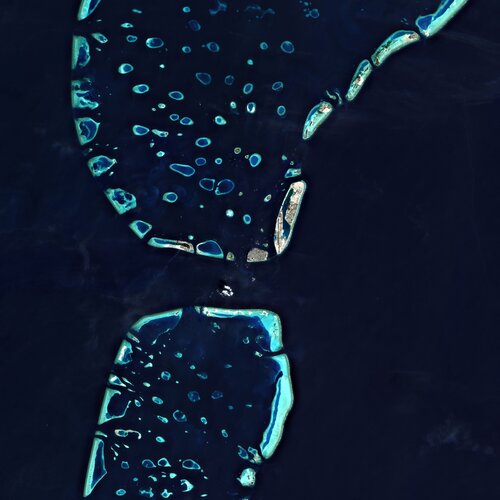
The Copernicus Sentinel-2 mission takes us over Malé – the capital and most populous city in the Republic of Maldives.
New Russian lab briefly knocks space station out of position

Russia's Nauka science module docks with ISS

Russia's long-delayed lab module successfully docked with the International Space Station on Thursday, eight days after it was launched from the Russian space launch facility in Baikonur, Kazakhstan.
The 20-metric-ton (22-ton) Nauka module, also called the Multipurpose Laboratory Module, docked with the orbiting outpost after a long journey and a series of maneuvers.
The launch of Nauka, which is intended to provide more room for scientific experiments and space for the crew, had been repeatedly delayed because of technical problems. It was initially scheduled to go up in 2007.
In 2013, experts found contamination in its fuel system, resulting in a long and costly replacement. Other Nauka systems also underwent modernization or repairs.
Explore further
© 2021 The Associated Press. All rights reserved. This material may not be published, broadcast, rewritten or redistributed without permission.














